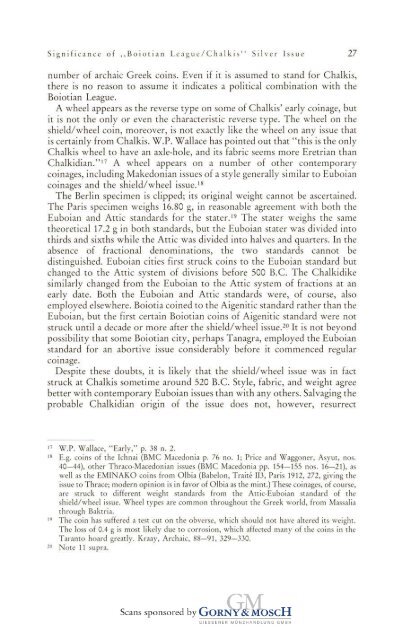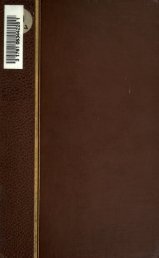jahrbuch numismatik geldgeschichte - Medievalcoinage.com
jahrbuch numismatik geldgeschichte - Medievalcoinage.com
jahrbuch numismatik geldgeschichte - Medievalcoinage.com
Erfolgreiche ePaper selbst erstellen
Machen Sie aus Ihren PDF Publikationen ein blätterbares Flipbook mit unserer einzigartigen Google optimierten e-Paper Software.
Significance of „Boiotian League/Chalkis" Silver Issue 27<br />
number of archaic Greek coins. Even if it is assumed to stand for Chalkis,<br />
there is no reason to assume it indicates a political <strong>com</strong>bination with the<br />
Boiotian League.<br />
A wheel appears as the reverse type on some of Chalkis' early coinage, but<br />
it is not the only or even the characteristic reverse type. The wheel on the<br />
shield/wheel coin, moreover, is not exactly like the wheel on any issue that<br />
is certainly from Chalkis. W.P. Wallace has pointed out that "this is the only<br />
Chalkis wheel to have an axle-hole, and its fabric seems more Eretrian than<br />
Chalkidian."17 A wheel appears on a number of other contemporary<br />
coinages, including Makedonian issues of a style generally similar to Euboian<br />
coinages and the shield/wheel issue."<br />
The Berlin specimen is clipped; its original weight cannot be ascertained.<br />
The Paris specimen weighs 16.80 g, in reasonable agreement with both the<br />
Euboian and Attic standards for the stater.'9 The stater weighs the same<br />
theoretical 17.2 g in both standards, but the Euboian stater was divided into<br />
thirds and sixths while the Attic was divided into halves and quarters. In the<br />
absence of fractional denominations, the two standards cannot be<br />
distinguished. Euboian cities first struck coins to the Euboian standard but<br />
changed to the Attic system of divisions before 500 B.C. The Chalkidike<br />
similarly changed from the Euboian to the Attic system of fractions at an<br />
early date. Both the Euboian and Attic standards were, of course, also<br />
employed elsewhere. Boiotia coined to the Aigenitic standard rather than the<br />
Euboian, but the first certain Boiotian coins of Aigenitic standard were not<br />
struck until a decade or more after the shield/wheel issue.2° It is not beyond<br />
possibility that some Boiotian city, perhaps Tanagra, employed the Euboian<br />
standard for an abortive issue considerably before it <strong>com</strong>menced regular<br />
coinage.<br />
Despite these doubts, it is likely that the shield/wheel issue was in fact<br />
struck at Chalkis sometime around 520 B.C. Style, fabric, and weight agree<br />
better with contemporary Euboian issues than with any others. Salvaging the<br />
probable Chalkidian origin of the issue does not, however, resurrect<br />
17 W.P. Wallace, "Early," p. 38 n. 2.<br />
18 E.g. coins of the Ichnai (BMC Macedonia p. 76 no. 1; Price and Waggoner, Asyut, nos.<br />
40-44), other Thraco-Macedonian issues (BMC Macedonia pp. 154-155 nos. 16-21), as<br />
well as the EMINAKO coins from Olbia (Babelon, Traite 113, Paris 1912, 272, giving the<br />
issue to Thrace; modern opinion is in favor of Olbia as the mint.) These coinages, of course,<br />
are struck to different weight standards from the Attic-Euboian standard of the<br />
shield/wheel issue. Wheel types are <strong>com</strong>mon throughout the Greek world, from Massalia<br />
through Baktria.<br />
19 The coin has suffered a test cut on the obverse, which should not have altered its weight.<br />
The loss of 0.4 g is most likely due to corrosion, which affected many of the coins in the<br />
Taranto hoard greatly. Kraay, Archaic, 88-91, 329-330.<br />
20 Note 11 supra.

















